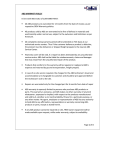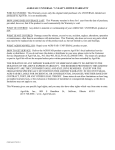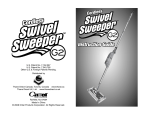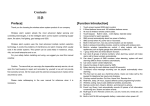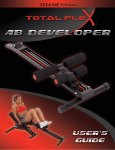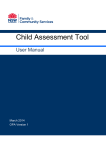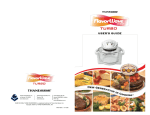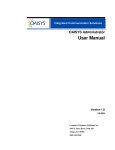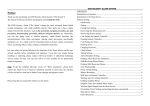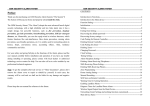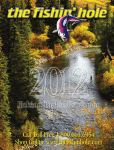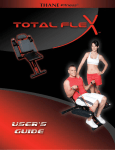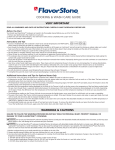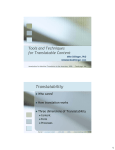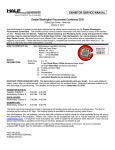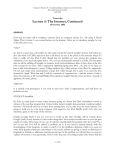Download Perfect Dog Perfect Dog
Transcript
Don Sullivan’s Secrets to Training the Perfect Dog System QUICK START GUIDE ESSENTIAL READING BEFORE YOU BEGIN ANY TRAINING WITH YOUR DOG Don Sullivan’s “Secrets to Training the Perfect Dog” System Quick Start Guide THANE DIRECT USA - 1 YEAR LIMITED WARRANTY The product you have purchased from Thane Direct USA is warranted against defects in materials and workmanship under normal use and service to the original owner for one (1) Year from date of original purchase (“Warranty Period”). Should the product prove defective during the Warranty Period, you must email or call our Customer Service Department at warranty@ecustomerresponse. com or (719) 948-1584. Do not return the defective part or unit unless instructed to do so after contacting us. Under this limited warranty, Thane Direct USA will replace any parts found to be defective due to a manufacturer’s defect. A shipping and processing charge will apply to any replacement undertaken by Thane Direct USA. This limited warranty is not transferable, extends only to personal use and does not apply to use of any product in a manner for which it was not designed or intended, or in a manner inconsistent with directions in the user’s manual or other instructions supplied with the product. After the expiration of this limited warranty, the cost of parts will be the responsibility of the original purchaser. EXCEPT AS PROVIDED IN THIS WARRANTY AND TO THE EXTENT PERMITTED BY LAW, IN NO EVENT SHALL THANE DIRECT USA OR ITS AFFILIATED COMPANIES be liable for any indirect, incidental, special or consequential damages arising out of or in connection with the use, misuse, inability to use or performance of the product, or any PRODUCT defect, including any economic loss, property DAMAGE, LOST profits, loss of enjoyment or use, costs of installation OR REMOVAL, or other consequential damages of whatever nature. Some STATES do not allow the exclusion or limitation of incidental or consequential damages. Accordingly, the above limitations may not apply to you. TO THE EXTENT PERMITTED BY LAW, THIS limited WARRANTY is the exclusive warranty granted by THANE DIRECT USA AND SHALL BE IN LIEU OF AND EXCLUSIVE OF ALL OTHER WARRANTIES, EITHER EXPRESS OR IMPLIED, INCLUDING WITHOUT LIMITATION ANY WARRANTY OF MERCHANTABILITY OR FITNESS FOR A PARTICULAR PURPOSE, STATUTORY OR OTHERWISE. This limited warranty gives you specific legal rights. You may also have other rights, which vary from STATE TO STATE. THIS LIMITED WARRANTY DOES NOT APPLY TO DAMAGE CAUSED BY THE FOLLOWING: 1. Accident, misuse, abuse or neglect. 2. Improper or inadequate assembly or maintenance. 3. Unauthorized modification or commercial use. 4. Improper packaging in return transit. 5. Normal wear and tear. 6. Unsupervised use by children under 18 years of age. TO OBTAIN WARRANTY SERVICE: The original purchaser should contact our customer care representatives via e-mail at [email protected] or by phone at (719) 948-1584. Depending on the extent of the service required, the original purchaser shall have the obligation and responsibility to: • Pay for all service and parts not covered by this limited warranty; and • Pay the applicable shipping and processing fee as specified by our customer care representatives. • If you are instructed to return the product (a) carefully package the product using adequate padding material to prevent damage during transit--the original packaging is ideal for this purpose; (b) include your proof of purchase, which includes the date of purchase; and (c) send to the address designated by our customer care representatives via USPS or carrier of your choice. FOR ALL INQUIRES, PLEASE CONTACT CUSTOMER Service for Warranty CLAIMS VIA E-MAIL AT [email protected] OR BY PHONE AT (719) 948-1584 Thane Direct USA is not responsible for any uninsured items lost in transit or costs incurred by the customer to return the product. Don Sullivan’s “Secrets to Training the Perfect Dog” System Quick Start Guide A message from “The DogFather”: Congratulations on your purchase of Don Sullivan’s “Secrets toTraining the Perfect Dog” System. Today is the day that you can begin to see an amazing transformation in the relationship with your dog. In order to ensure the maximum and quickest results using my System, there are some key points to follow, listed in my Quick Start Guide. This Guide is ESSENTIAL READING before watching the DVDs and before attempting any training with your dog. Remember, there is a vast difference between a dog off a leash and a dog that is trained to be off a leash. Freedom is the most precious gift that you can give to your dog, over and above love and affection, yet freedom can be dangerous and problematic unless it is also accompanied by trust. The “Trust Zone” is the point at which an owner can trust his dog to “behave,” regardless of distractions, without needing to be restrained by a leash or collar. My Quick Start Guide is the road to reaching the “Trust Zone,” quickly. As soon as you begin training towards the “Trust Zone,” you will begin to witness dramatic changes in your dog. This is particularly exciting if your main goal of using my System is to simply solve a few errant behavioral problems. Now you no longer need to dream of having the best relationship possible with your canine companion. With my System, and my Quick Start Guide to help you on your way, you will quickly unleash the true potential that lies within your dog. I look forward to hearing of your success, just as I have with countless other dog owners around the world. Sincerely, Don Sullivan “The DogFather” Host, “Doggin’it” TV Show Former Trainer at Sealand Guest TV & Radio expert 2 Don Sullivan’s “Secrets to Training the Perfect Dog” System Quick Start Guide BEFORE BEGINNING ANY TRAINING WITH YOUR DOG, it is ESSENTIAL that you read all of the Quick Start Guide, as well as watch at least the following introductory segments on disc one of the DVD set. After watching and applying the instruction within these segments, you can then begin to focus on other segments as needed. It is not necessary to watch both DVDs in their entirety before beginning any training with your dog. However, those who try to absorb as much information as possible, as their first step, generally obtain the best results. WARNING: If, at any time, you feel that you are struggling, we strongly advise that you return to this Quick Start Guide and the training DVDs to identify any weaknesses in your application of the training techniques. Don Sullivan’s System is a proven success, with all manner of dogs and problem behaviors. Those who do not achieve the results that they desire are generally those who do not make every effort to implement the training instructions properly and thoroughly. Important introductory segments Getting Started: Training Philosophy, Golden Rules, Training & Treats, Incorporate Training into Daily Routine Equipment: All segments Commands: Pulling on the Leash, Down Command Exercise: Retrieving, Playing, Fun Fetch Ball (for those who purchased this accessory in addition to the System). Notes: 1. If you did not purchase the Fun Fetch Ball, you can still order it (or any other Accessories) by filling in the order form, or by logging on to The Perfect Dog website at one of the following: U.S. Sales - www.thane.com (Click on The Perfect Dog product listing) Canadian Sales - www.thane.ca (Click on The Perfect Dog product listing) For all other countries - www.thanedirect.com (Go to your country home page, and then click on The Perfect Dog product listing) 2. The “FAQs” (Frequently Asked Questions) page and “How it Works” page on The Perfect Dog website are also very good sources of information. Within the 5 hours of instruction that Don Sullivan has included in his DVDs, you will find the answers to almost any variable that may arise with your dog. The training DVDs include over 70 different segments and a multitude of 3 Don Sullivan’s “Secrets to Training the Perfect Dog” System Quick Start Guide techniques to deal with all common behavioral problems. If you do not see your dog’s particular behavior problem specifically listed below, you will be able to effectively apply one or more techniques discussed and demonstrated in the other segments to find a solution. All of Don’s training techniques can be applied with multiple dogs, simultaneously. The following is a complete list of topics covered, included detailed descriptions: Getting Started Training Philosophy (7:54): In-depth theory behind Don Sullivan’s training method. Golden Rules (6:29): The critical points to remember when training your dog. Training & Treats (the detrimental effects) (3:16): Why Don Sullivan discourages the use of food bribery as a method of training/motivation; how treat training achieves limited and often superficial results compared to Don Sullivan’s techniques. Children & Training (0:49): How to successfully incorporate your children into the training process and the key issues to remember when doing this. Verbal Baiting (2:41): How to avoid common enticements that will undermine your training success. Incorporating Training into Daily Routine (3:20): How to save time by training your dog in everyday real life situations, as you interact with him as part of your daily relationship together. Trust Zone (1:17): A vision, and demonstration, of the ultimate goal every dog owner should have for his dog: Freedom. Housebreaking (14:25): A step-by-step process to teaching your dog (whether a brand new puppy or an older dog with bad habits) to relieve himself where YOU would like him to. How to achieve success no matter what you have experienced with your dog so far, including learning to be “in tune” with your dog’s signals for needing to “go potty” outside. Note: The techniques taught in this segment, in combination with those in other segments, will help to correct the issue of “excited peeing.” Equipment Essential Equipment (3:29): An explanation of the essential training tools to use for each dog (Command Collar™, 3 Freedom Training Lines etc.); how they operate, in what situations to use them, and the key things to remember. Specialized Equipment (6:45): Other useful training tools to consider for specific situations; how they operate, in what scenarios to use them, and the key things to remember. Command Collar™ (3:33): A detailed demonstration of the Command Collar™; how to adjust the collar to suit your dog’s neck size; how to attach and remove easily once initially sized; key things to remember. 4 Don Sullivan’s “Secrets to Training the Perfect Dog” System Quick Start Guide Electronic Collar (3:44): A discussion of the practical and appropriate applications of an electronic collar, as an optional fine-tuning training device. Note: The vibration mode on these collars is useful for owners with hearing impaired dogs, when combined with the use of the Command Collar™ and Freedom Training Lines, as well as the hand signals that Don Sullivan teaches in his DVDs. Prong Collar (4:53): A discussion of the Prong Collar, as an optional training tool for dogs with exceptionally challenging personalities. Useless Equipment (to avoid) (3:37): A discussion of other collars and dog training devices on the market; their limitations and how they can actually be detrimental to achieving successful results. Retractable Leash (1:21): Why Don Sullivan discourages dog owners from ever using a retractable leash. Commands (Correcting) Pulling on the Leash (13:13): How to get your dog to stop pulling on the leash, and walk calmly with you (but not necessarily at a strict “heel” position) within minutes, no matter the struggles you have endured so far. Sit Command (5:27): How to teach you dog to sit on command. Also, putting the “Sit” command into perspective, compared to more useful commands. Down Command (6:50): How to teach your dog to lie down on command. Also, why this is one of the most useful commands; and how it is critical to training success, based on Don Sullivan’s training theory. Stay Command (4:21): How to teach your dog to stay in any position (even on his bed in the house, if you want him to), for any length of time, until released. Down from a Distance (4:36): How to teach your dog to lie down when he is at a distance from you; even if he is in the middle of running e.g. retrieving a toy. Hidden Stay Command (1:49): How to teach your dog to remain in a “Down” position for any length of time, while you are hidden from his sight, until released. How this command can be useful. Cautions and safety measures. Come Command (7:21): How to teach your dog to come to your side whenever you call him, no matter what he may be distracted or tempted by. Heel Command (7:02): How to teach your dog to walk precisely by your side, without being restricted by a tight leash. How this command can be useful in certain situations, but not to be used on a regular basis. Moving Off-Leash (8:08): How to progress from the above commands, using the Command Collar™ and all 3 Freedom Training Lines, to needing no training equipment at all. How to reach the point of being “in tune” with your dog so that he not only understands and obeys the new rules and boundaries, but he actually anticipates situations and controls himself of his own accord before you even have to say anything. 5 Don Sullivan’s “Secrets to Training the Perfect Dog” System Quick Start Guide Exercise Retrieving (11:43): How to teach your dog to chase after the ball/toy, bring it back, and willingly place it in your hand (without a game of tug-of-war!). Also, how to get your dog to drop the ball/toy on command; this technique can be transferred to any other objects that you wish your dog to release from his mouth e.g. if your dog likes to chew on the leash. Playing (1:06): The importance of incorporating play time into the training process; how this works to be a key reward and motivation for obedience and good behavior. Off-Leash Control (4:17): Why reaching the goal of having control over your dog’s actions (and, in fact, teaching your dog to curb his own temptations to disobey or misbehave) is critical to a safe, harmonious, and fulfilling dog/owner relationship. (Thoughts on) Dog Parks (6:20): Don Sullivan discusses local dog parks; how the influence of the misbehavior that goes on in these environments can undermine your training efforts. Don offers exciting alternatives to allowing your dog to exercise and socialize in fun environments. Swimming (2:48): Step-by-step instruction to teach your dog not to be afraid of the water; then to swim confidently and even retrieve water toys. Fun Fetch Ball (2:53): How to use the Fun Fetch Ball to teach your dog to retrieve; how this tool can help save your arms/shoulders from the strain of continually throwing the ball/toy; how to progress to using a racket and ball to give your dog the intense cardiovascular exercise that he needs in order to burn off his excess energy (thereby limiting the potential for annoying and destructive behavior). Socializing (1:54): The importance of teaching your dog how to harmoniously intermix with other dogs, and with other people. When to begin socializing a puppy. Key points to be aware of. Problem Behaviors Introduction (2:21): Overview of problem dog behaviors and Don Sullivan’s approach to successfully resolving them for life. Barking (6:17): How to stop your dog from barking, at anything, whether it be other animals, people, the doorbell, other noises, moving objects, or even as a part of his exuberant personality, no matter what you have tried to date to fix the problem. Begging (6:29): How to stop your dog from begging or “mooching” for food. How to teach him to respectfully keep his distance while you are eating. Bolting (4:48): How to effectively deal with your dog if he runs away from you outdoors. How to safely retrieve him, and teach him to control his temptation to bolt, no matter the intensity of the distraction or temptation. Chasing cars/bikes/etc. (2:44): How to teach your dog to enjoy the various elements of everyday life (cars, bikes, skateboards, strollers, cats, squirrels, other dogs etc.) without chasing them, barking at them, or showing any signs of aggression, or other undesirable behavior. 6 Don Sullivan’s “Secrets to Training the Perfect Dog” System Quick Start Guide Chasing & Nipping People (3:17): How to teach your dog to keep his mouth off people (adults and children); and how to remain calm and controlled as people move about him (even children running around). Chewing Hands/Nipping (3:04): How to teach your dog to play and interact with you and other people without mouthing/chewing on your body or clothes, nipping, or showing any signs of aggression. Chewing (3:57): The importance of providing your dog with acceptable items to chew, as one of his natural instincts and life needs. Items to avoid and examples of acceptable chew “toys.” How to stop your dog from chewing all “out of bounds” items such as household furnishings; and how to train your dog to exercise self-control so that you can trust him alone in the house, car, office etc. Chewing on Leash (1:02): How to get your dog to stop chewing on the leash/Freedom Training Lines. (The technique for “Drop” under Retrieving is also an effective technique for solving this problem). Clipping Nails (3:08): How to teach your dog to remain calm and controlled while you trim his nails, bathe him, administer/apply necessary medication, and generally groom him. Once you have trained him to overcome his fear, or squirminess, or unbridled energy in these situations at home, your dog will be well equipped to control his urges while at the groomer or veterinarian etc. Counter Surfing (2:09): How to stop your dog from being a “food thief” in the kitchen, at the dinner table, during family barbecues; even when you are not present to keep an eye on him. Don Sullivan will empower you to teach your dog to respect the boundary between your food and his; from children with ice cream cones, to even being left alone at home with tempting food left on the counter. Crazy in Car & Relax Command (2:46): How to teach your dog to ride peacefully and happily with you in the car; without jumping around, barking, whining, or behaving in any other undesirable way. How to use the “Relax” command to calm your dog in the car, or in any other situation where he is acting unruly; and how to use this command as a preventative measure before your dog acts upon his urges. Crazy in Crate (3:37): How to teach your dog (even your brand new puppy) to rest calmly inside a training kennel (used primarily during the housebreaking process, and for travel), without barking, whining, jumping around, biting/chewing the cage, or behaving in any other undesirable manner. Desensitization (3:40): Don Sullivan discusses situations where some dogs develop an intense sensitivity to certain situations or objects, from vacuum cleaners, or heavy traffic, to even parked cars. How to effectively deal with these situations, reprogramming your dog to rely upon his newly found confidence and emotional stability. Digging (3:00): How to get your dog to stop digging in the yard/garden, no matter what you have tried so far. 7 Don Sullivan’s “Secrets to Training the Perfect Dog” System Quick Start Guide Getting into Garbage (1:12): How to stop your dog from raiding the garbage can; in the kitchen or outdoors. This same technique can also be used to discourage your dog from getting into any other household items such as boxes of kids’ toys, knitting basket, office waste basket, and closet. Jealousy (2:36): How to teach all your dogs to live harmoniously together, to the point of even sharing a large bone together! Jumping Up (8:18): How to stop your dog from jumping on you (adults and children) within minutes, no matter how excited he is to see you. Also, how to stop your dog from jumping on others; from guests at the door to strangers in the street. Licking (2:00): How to stop your dog from licking your (or others’) hands, face, etc., in minutes, as you play and interact with him. Licking – Small Dogs (1:38): Don Sullivan teaches you his simple, quick technique for stopping very tiny dogs and puppies from licking people’s hands, faces, etc. Separation Anxiety (3:08): Don Sullivan shares his understanding of why some dogs “freak out” when left alone in the house, car, etc. He teaches you effective techniques to reprogram your dog to calmly and confidently deal with these situations; to be accepting and trusting of your decisions to leave him alone for a certain time. Aggression All Aggression (7:25): The various types of aggression, why they occur, and the general approach to take in dealing with them. A step-by-step approach to training an aggressive dog to control his aggressive urges, whether the source is fear or dominance. This technique can be used whether the aggression is toward people, other dogs in your home, strange dogs, or other animals e.g. cats. Aggression towards People (9:07): Don Sullivan discusses and demonstrates specific techniques used to teach your dog to confidently and calmly interact with all people (adults and children), without him exercising any form of dominance. If followed properly, this technique will help you to redirect your dog’s mind towards a more positive channel of harmonious socialization. Fear Aggression (3:47): Don Sullivan discusses why some dogs resort to aggression as a means of trying to deal with their fear or lack of confidence. How to effectively reprogram your dog to adopt a confident, mature and calm outlook on all situations, whether the source of his fear is people, other animals, moving objects, natural occurrences e.g. lightning, or any other. Aggression over Food (5:21): How to teach your dog to stop being possessive over his food, whether with you, others, or with other dogs. Using Don Sullivan’s techniques you can learn how to place down or remove your dog’s food dish or bone without any resistance or challenge from your dog. Aggression – Small Dogs (2:51): Don Sullivan discusses the traps of promoting dominant and outwardly aggressive behavior in your small dog. Key points to be aware of, and what to do when your small dog meets larger dogs. 8 Don Sullivan’s “Secrets to Training the Perfect Dog” System Quick Start Guide (Thoughts on) Guard Dogs (5:32): If desired, how to maintain your dog’s protective nature (for the chance situation where it will be truly warranted) without allowing him to display dominance or aggression in regular daily life. Don Sullivan discusses building an “off-switch” into your communication with your dog, so that he understands and obeys the boundaries that you set. Sharing Bones (1:14): The key considerations for creating harmony between all the dogs in your home, to the point of even happily sharing a big bone together. Perimeters & Boundaries Bolting out the Door (7:34): How to teach your dog to respect the boundary of an open doorway; to teach him to wait of his own accord at the doorway, until released, no matter what kinds of distractions and temptations (e.g. children playing in the front yard) are vying for his attention. Answering the Door (3:44): How to stop your dog from bombarding the doorway whenever the doorbell rings. How to teach your dog to calmly remain at a respectful distance, and allow your guests to enter, without your dog barking, jumping, or exhibiting general over-exuberance. Staying off the Road (5:14): A five step process for teaching your dog to never enter the roadway without your permission. This very effective technique can be used in any number of boundary line or perimeter situations (that you decide upon) either inside or outside the house. (No more) Baby Gates (3:45): How to teach your dog to stay out of certain rooms inside the house (if this is your desire), of his own accord, without having to use physical restrictions such as baby gates or closed doors. Freedom in the House (3:52): How to deal with your dog at home in a mature and appropriate manner, so as to help him behave acceptably within the boundaries that you have established. Camping Boundaries (2:28): How to teach your dog to remain within your campsite radius, of his own accord, without physical restriction. Boundary Line Caution (2:50): Important points to remember when teaching your dog to respect the boundaries and perimeters that you set around your home, by using the “Staying off the Road” training technique. Boundary line training is one of Don Sullivan’s advanced techniques, but caution must be exercised and the technique must be properly and thoroughly implemented. If you do this then the results can be astounding! Miscellaneous Getting in the Car (1:14): How to teach your dog to confidently enter the vehicle of his own accord, without waiting for help from you. (For those dogs that are capable). Safe Driving (3:08): Various considerations for keeping your dog safe when he travels with you in the vehicle. 9 Don Sullivan’s “Secrets to Training the Perfect Dog” System Quick Start Guide Safe Boating (1:56): Various considerations for keeping your dog safe when he goes boating with you. Safe Hiking (2:45): Various considerations for keeping your dog safe and sufficiently hydrated when he accompanies you on a hike. (Thoughts on) Neutering (2:00): Don Sullivan discusses his opinions on the neutering of male dogs; the pros and the cons. Tricks & Fun Things (4:28): Don Sullivan teaches dog owners how to be creative when interacting with their dogs; he demonstrates a number of “fun things” to do with your dog, to build your relationship and to keep your dog stimulated and challenged. 10 Don Sullivan’s “Secrets to Training the Perfect Dog” System Quick Start Guide Critical Steps to Follow 1. Watch through the segments, “Training Philosophy,” “Golden Rules,” and “Treats & Training,” under “Getting Started,” disc one, before starting any training with your dog. 2. Watch all of the segments under “Equipment,” disc one. Here you will learn how to use the Command Collar™ and adjust the size to custom fit your dog, and thereafter use the quick release snap to attach/remove the collar from your dog’s neck. You will also learn how to use the 3 Freedom Training Lines. Note: The Command Collar™ should fit reasonably snuggly around your dog’s neck, with enough room to easily fit one finger underneath. 3. Watch the segment, “Pulling on the Leash,” under “Commands,” disc one, which will help you teach your dog to never pull on the leash. Correcting leash pulling is an imperative step in the process of gaining your dog’s respect. You must maintain a zero tolerance for pulling on the leash. You cannot make excuses for your dog’s pulling such as, “He seems unable to control himself when he’s distracted.” If Don’s technique is followed properly it should only take a few minutes to get your dog to stop leash pulling, forever. The purpose of this exercise has nothing to do with getting your dog to walk tightly beside you at a “heel” position, but rather to teach your dog to respect the boundaries of a loose leash. The “Pulling on the Leash” exercise is the building block and beginning stage of solid off-leash control. 4. Watch the “Down Command” segment, under “Commands,” disc one. As mentioned in this section, your initial goal is to get your dog to perform three “Down” commands in a row, without needing any correction. After this, you can start adding distractions at increasing levels, such as throwing a ball on the ground or having a small child run by. Ultimately, you want your dog to respond to a “Down” command the first time, every time, wherever you issue the command, and to hold the command until you release him, however long that might be. 5. Begin any new training exercise relating to your dog’s most prominent issues. 6. Work your dog inside the house as well as outside the house so that either place does not become a situation of “free for all.” 11 Don Sullivan’s “Secrets to Training the Perfect Dog” System Quick Start Guide 7. A very useful segment to focus on early in the training process is, “Retrieving,” under “Exercise,” disc one. Sufficient intense exercise on a daily basis is critical to keep your dog from releasing his energy in undesirable ways. It is vital for his health and emotional well-being. Apart from retrieving, there are other options for intense cardiovascular activity such as bike riding with your dog (still making sure that he does not pull on the leash), and swimming. Exercising your dog does not have to take a lot of time. Most dogs can be satisfied with two 20 minute sessions of continuous vigorous exercise each day. When you can trust your dog to retrieve for you every time, you can then easily, efficiently, and joyfully satisfy one of his most important needs. Retrieving also serves as useful play time, and a positive fun reward, in between training periods, whether inside or outside the house. The Fun Fetch Ball is the perfect tool for teaching your dog to retrieve. (Watch the “Fun Fetch Ball” segment, under “Exercise,” disc one). 8. If you have more than one dog, you will need one Extra Equipment Set (Command Collar™ and Set of Freedom Training Lines) for each of your dogs that needs training. You can order Extra Equipment Sets in both Large and Small by logging on to The Perfect Dog website at one of the following: US Sales - www.thane.com (Click on The Perfect Dog product listing) Canadian Sales - www.thane.ca (Click on The Perfect Dog product listing) For all other countries - www.thanedirect.com (Go to your country home page, and then click on The Perfect Dog product listing) 12 Don Sullivan’s “Secrets to Training the Perfect Dog” System Quick Start Guide Overview See changes in just minutes! You should be able to see a positive change in your dog, within minutes, when you begin to apply Don’s training techniques properly. In a sense, you will learn a new “language.” In order to maximize results in the quickest time possible, you need to be wholeheartedly willing to change the way you communicate with your dog, including ceasing all unproductive or detrimental communications and actions which could undermine the transformation process. Why off-leash training is so important The Perfect Dog System is well capable of empowering you to achieve complete off-leash control of your dog, yet Don Sullivan recognizes that not every dog owner’s goal is going to be the same, given differences in lifestyle, personal preference and physical abilities. Ultimately, Don hopes to see every dog earn the precious off-leash freedom which his own dogs enjoy, but everyone must assess their own abilities before developing their goal. For example, if you are somewhat limited in your physical abilities, you will at the very minimum gain a calmer, more attentive, less problematic dog by applying some of the most basic elements of the program. Although Don encourages off-leash freedom as the ultimate goal and reward for any dog, the fact is that leash laws do exist. However, even though you may be required to have your dog leashed in certain public environments, this in no way diminishes the importance of training your dog to be trustworthy off a leash, especially when there are lots of distractions and temptations. This “Trust Zone” will not only ensure the safety of your dog whenever there is an opportunity to give him freedom and proper exercise, it will also let you rest in confidence knowing that your dog will not cause any disruption or destruction. Due to previous unsettling experiences, there are many dog owners who would never even think to allow their dog to be off a leash, unless in a very controlled environment. However, the reality of life is that circumstances are bound to arise beyond a dog owner’s direct control, such as a door or gate accidentally left open. Even these especially cautious dog owners need to recognize the value of the “Trust Zone” for the sake of their dogs’ lives and their own peace of mind. These owners also need to recognize the value of sufficient off-leash exercise for the health and emotional well-being of their dogs. 13 Don Sullivan’s “Secrets to Training the Perfect Dog” System Quick Start Guide The first week During the first week of using The Perfect Dog System, your dog might, in some ways, attempt to regain the control that he was accustomed to having. He may even develop some new and interesting behaviors to try to circumvent your attempts to become his respected leader. This is a normal part of the re-training process, but as long as you continue to move forward and do not succumb to his will, you will see that your dog is more compliant by about week two. Establish yourself as the leader When clear leadership is given, every dog will respond immediately, but it is natural for a dog to then test the consistency of that leadership, especially if the person that they are dealing with has an established history of being passive and submissive to the dog. Be prepared to provide consistency to maintain the changes experienced until these changes become firmly implanted in the behavioral patterns of your dog. Although many people have heard it said, “Consistency is the key to a well trained dog,” this in fact is only half the answer. The other half of the equation is an appropriate level of correction for the individual strength of will and personality of your dog. If you correct your dog at a level lower than necessary for his character (i.e. at a level lower than your dog respects), you will only consistently reinforce in his mind that you are subordinate to him; not his leader. Never use treats! NEVER use food/treat rewards for any of Don’s training techniques. Don Sullivan also recommends no food to be given to your dog from any human hand, at any time. Always make sure all food given to your dog takes place from his food dish, and always make a separation between the food you (and others) eat and the food given to your dog. It is not necessary to use food bribery in connection with any commands given and, in fact, handing your dog food is detrimental to the training process, as explained in the “Training & Treats” segment, under “Getting Started,” disc one. 14 Don Sullivan’s “Secrets to Training the Perfect Dog” System Quick Start Guide Mutual respect & affection Many people find the “no treats rule” hard to adjust to when they have already established this habit with their dog. However, by immediately ceasing to give any food/treat rewards once you have begun training using The Perfect Dog System, you will help to convey the message to your dog that “things are changing.” Rest assured that your dog’s love for you will not diminish in any way because you are no longer buying his attention with treats. Though he may try to badger you with emotional blackmail for a week or so, he will eventually realize that his relationship with you is now based on respect and mutual affection rather than food. 15 Don Sullivan’s “Secrets to Training the Perfect Dog” System Quick Start Guide Some Golden Rules Note: Be sure to watch the “Golden Rules” segment, under “Getting Started,” disc one, for an in-depth explanation of all the important points to remember. 1. Incorporate training into the daily routine with your dog. In the first few days you will have to set aside short blocks of time to introduce your dog to new concepts, but once your dog has learned these commands, simply incorporate them into the time you normally spend with him. For example, instruct your dog to hold a “Down, Stay” command while you do the dishes or read the newspaper. Watch the segment, “Incorporate Training into Daily Routine,” under “Getting Started,” for more ideas. 2. It is imperative to leave the Command Collar™ and one of the Freedom Training Lines on your dog at all times when someone is present to supervise, whether outside or inside the house, until you reach your overall training goal. For the most part, this will mean that your dog will constantly wear the equipment, other than when you/he sleeps at night and whenever your dog is home alone. When you have reached your training goal, you can then begin to “wean” your dog off the training equipment. Failure to adhere to this important point will undermine your training success. The collar and line allow you to establish consistent control in casual real life situations. If you make training a separate activity, your dog will pretend to respect you during that time yet take advantage of opportunities to enforce his own will when he is free of the training equipment. If you are consistent in leaving the collar and line on at all times, your dog’s mind will quickly reprogram and he will lose the urge to challenge you as time progresses. Safety point: Do not leave the equipment (Command Collar™ or Freedom Training Lines) on your dog when there is no-one present to supervise. 3. Do not enforce long, repetitive “drills” with your dog on any command. Once you have gained a positive response a few times consistently, take a break and play with your dog. For example, once your dog has performed a “Down” command three times in a row, any more repetition at that point will only be a source of frustration to your dog; it will not increase his responsiveness to you. A dog is an intelligent creature; he does not need hundreds of repetitions on one simple concept for him to grasp the idea. Once your dog has performed a command, he absolutely understands what is expected from him. 16 Don Sullivan’s “Secrets to Training the Perfect Dog” System Quick Start Guide At this point he only needs to develop his knowledge in terms of how long and in what situations you expect him to follow your instruction. Your dog has an amazing memory and he will not forget what he has shown compliance to. Any non-responsiveness in the future is a function of disrespect, not a lack of understanding or forgetfulness, as long as your instructions have always been clear. If your dog starts to revert back to his old ways i.e. you find that your dog is not responding to you in certain situations, then it is not because he has forgotten; there has simply been a weakening in your leadership and he is taking advantage of this. In his DVDs, Don Sullivan empowers you to monitor your own self and the way that you are dealing with your dog, so that you can recognize and reverse any weaknesses that may emerge. 4. Whatever concept you are teaching, start your corrections at a moderately soft level and increase the firmness of your corrections until your dog is responding in the desired manner. Your dog will decide at what point your correction level is appropriate for his individual strength of will and personality. At this point he will obey. This principle (starting “low” and then increasing the correction level until it is sufficiently discouraging to your dog) is the SAME for stopping ANY bad behavior. 5. Every command you teach and every problem you correct will have an impact on all other areas of your dog’s behavior. You may find that, having just taught or reinforced a command, a certain unrelated problematic behavior suddenly disappears. This is no coincidence. It is the direct result of your dog learning to respect you as his leader. 6. Your goal is to control the will of your dog. This simply means that your dog will respond to any command or instruction you give, regardless of your dog’s desire to respond to distracting or tempting influences. When you have control over the will of your dog, you can reward him with the precious freedom that he desires and needs to enjoy his life to the fullest. You will also experience peace of mind knowing that your dog is safe and your life with him is in order, and you will have joy in your heart knowing that you are truly giving your dog the best you can offer him. 17 Don Sullivan’s “Secrets to Training the Perfect Dog” System Quick Start Guide Progressing to Off-Leash Obedience To maximize your success with Don Sullivan’s System, it is imperative that your dog wears the Command Collar™ and one of the Freedom Training Lines (3 lengths to choose from depending on whether the dog is inside or outside the house, and depending on the stage that you are at with the training) at all times, when someone is present to supervise. This means that you will remove all of the equipment only when you go to bed at night, and whenever your dog is home alone. Especially make sure that you attach the equipment first thing in the morning, or immediately upon returning home, the moment you first see your dog. Any delay in this will give way to opportunities for your dog to misbehave and, without the means to correct any unruliness or disobedience, your dog will “win” in these situations, thereby undermining the training process. If you separate “training” from your other interactions with your dog, your dog will become “collar smart,” and he will only “behave” when the equipment is on. He may behave in part when the collar and line are off, but most likely he will challenge you because there is no way for you to effectively reinforce your instructions should he choose to disobey. The Command Collar™ and Freedom Training Lines are TEMPORARY tools only. They are NOT to be used for the rest of your dog’s life. The idea is to gradually wean your dog off the training equipment to a point where you can trust him to obey the boundaries and rules that you have set for him, when off the line/ collar, and even when exposed to a great amount of distraction and temptation. For example, in the first few days you can use the medium length Freedom Training Line to correct pulling on the leash and to teach your dog to walk calmly near you (not necessarily at a “Heel” right beside you). Then, you will proceed to walking with your dog, drop-leash, still with the medium length line (or even with the longest line if your dog has a history of bolting). The next steps will be to work your way down to walking with just the Command Collar™ and shortest Freedom Training Line. You will do this at a pace that suits you and your particular dog (e.g. some dogs will be more tempted by distraction, such as kids on bikes and squirrels, than others). A more advanced step will be to not only walk with your dog, but also take him to the local park to throw the ball and play with him, teaching him to “stick around” without running off after other dogs, people etc. Whilst you may be walking with your dog, by this stage, with only the collar and short line, you 18 Don Sullivan’s “Secrets to Training the Perfect Dog” System Quick Start Guide may want to go back to the medium or even long line, just when in these more open and distracting type environments, until again you are able to wean your dog down to the shortest line. When you get to the point where you can sufficiently trust your dog to just wear the collar and short line at all times, with perhaps only the odd “maintenance” correction, then your dog is experiencing relative off-leash freedom. When your dog has been behaving well in all real life situations (at home, in the car, going for walks, at the park, at the vet etc.), with only the Command Collar™ and shortest Freedom Training Line, for about two to three weeks, then you can consider removing the training equipment altogether, and your dog will be able to live a life completely free of training gear. (Unless, of course, you enter a strict on-leash zone. In these cases you will have to obey the law, even though your dog is quite capable of behaving unrestricted). It is up to you to judge at what point you can have sufficient confidence in your dog to truly give him the all-round freedom that he needs and deserves. If you are unsure, then best to keep the Command Collar™ and shortest Freedom Training Line on your dog for another two to three weeks, until you can confidently anticipate how your dog will act in all real life situations. You will reach the point where you and your dog are “in tune” with one another; he understands what is expected of him and he respects the new “rules,” and you know that not only your voice commands and instructions will be obeyed in all situations, but your dog will actually anticipate situations and control himself before you even have to say anything. Note: If, at any point, you notice a degree of regression in your dog’s behavior, this will most likely be because your dog has noticed a weakening in your dealings with him and he has started to take advantage of this. If this occurs, immediately go back one or two steps. For instance, if your dog is at the point of wearing no collar or line at the park, and he starts to consistently ignore your instructions, then return to using the Command Collar™ and at least the medium length Freedom Training Line until you “regain the ground” that you lost. 19 Don Sullivan’s “Secrets to Training the Perfect Dog” System Quick Start Guide Training More Than One Dog Simultaneously The Command Collar™ and Freedom Training Lines are used together throughout the entirety of the training process (all three lines are used for different situations). You cannot apply Don Sullivan’s training techniques with the Command Collar™ alone, and it will not work to share one set of lines between your dogs. This is why you will need a full set of training equipment (Command Collar™ and 3 Freedom Training Lines) for each of your dogs. (Refer to “Critical Steps to Follow” for ordering details). One of the keys to success with Don Sullivan’s System is ensuring that each of your dogs wears a Command Collar™ and appropriate length of Freedom Training Line at all times (while supervised), until you have reached your goals for each of them. Don Sullivan strongly recommends that you train all of your dogs simultaneously. However, your initial approach should be, as far as the foundational commands are concerned, to work each dog individually for the first week. This will obviously require a little more time compared to someone with just one dog, but as you enter into the second week and find each of your dogs becoming more responsive to you, you can then begin to work the dogs together, which will then save you time. This approach will give you a more solid result with all of your dogs. If you do not begin the same training process with each of your dogs simultaneously, then the untrained dogs can negatively influence the dogs that you are working with, and this will undermine your training success. Even though your dogs may be very different in terms of personality, age, or problematic behavior, the core of Don’s training program is consistent for all dogs, no matter the breed, age, size, personality, instincts, intelligence, past training or past experiences of your dogs; and no matter the type or intensity of your dogs’ problem behaviors. The only difference will be the levels at which you will need to deal with your individual dogs. 20 Don Sullivan’s “Secrets to Training the Perfect Dog” System Quick Start Guide Everyone (Even the Housekeeper!) Should Be Involved Don Sullivan’s System can be easily implemented by any family member, as long as the person is old enough to comprehend the concept of Don’s training method. In fact, Don recommends that every member of the household should be involved in the training process, to maximize the results. (Please exercise caution when young children are in the presence of your dog, most particularly if your dog has aggressive tendencies). Don recommends that the adults begin the training process and then gradually involve the children at the parent’s discretion. Dogs operate on a hierarchy where each dog has a place in the pack. Though there is one ultimate leader, all the subordinates will have established a place for themselves on the “social ladder.” All family members (even the housekeeper and gardener) will be able to be leaders of the dog, as long as everyone follows the same methodology, properly and thoroughly, as instructed on the DVDs. Even if one person spends the most time with the dog, it is still important for all members to work with the dog during the training process. One person can always lead the way, taking the first few days to effect some positive changes in the dog’s behavior. Then, others can step in, either simultaneously or in stages. This will make it easier for them because the dog will already be accepting of a new order of things within the family. The goal of each family member should be to gain the respect of the dog so that the dog will follow their lead and obey their instructions without challenge. It does not matter which person ultimately arises as the overall “pack leader.” As long as all members effectively reposition themselves to be above the dog, the dog will be attentive to them all. Importantly, each person must be actively involved in rewarding the dog, as an integral part of the training process; offering praise, affection, play and, ultimately freedom, to the dog (but NEVER any treats!). Note: If you have young children, please discipline them to not touch the Freedom Training Line and Command Collar™ while they are attached to the dog. If your child plays with or tugs on the equipment, it can confuse your dog in terms of what is expected of him. It can also provoke the dog, which can be dangerous, particularly if your dog has aggressive tendencies. 21 Don Sullivan’s “Secrets to Training the Perfect Dog” System Quick Start Guide Some Common Questions Will my dog really change in minutes? Don Sullivan’s System is not a magical wand. All of your dog’s problems will not suddenly disappear overnight. The message of the infomercial is, “See positive changes in your dog’s behavior, within minutes.” And, we do guarantee that you will begin to witness positive changes in some areas of your dog’s behavior as soon as you start using The Perfect Dog System, as long as you apply the techniques as instructed. Once you have read through this Quick Start Guide, and watched the training DVDs, thoroughly, and once you understand the “essence” of Don’s training method, you will be empowered to effectively implement the various techniques, stage by stage. As you start training, you will immediately begin seeing certain positive changes in your dog’s behavior, and his good behavior will grow exponentially as you progress through the DVD segments. When I have the Freedom Training Line on my dog, no matter which size, he always tries to chew on it. Is this detrimental to the training program? Is there a way to correct this? Yes, you do need to stop your dog from chewing on the lines. Please watch the “Chewing on Leash” segment of the DVDs. You will also find the technique used to teach “Drop,” under the “Retrieving” segment, very helpful. Between these two techniques you will find a solution. If your dog continues to chew on the line, then remember that he is simply not respecting the LEVEL of correction that you are giving him; so you need to increase the correction (but not the volume of your voice) until your dog decides that it is not worth chewing on the lines. This principle (starting softly and then increasing the correction level until it is sufficiently discouraging to your dog) is the SAME for stopping ANY bad behavior. My dog has several behavioral issues that need to be dealt with but I am not sure if I should work on correcting him for all of his issues throughout the day as they come about, or only focus on one at a time. You should address all behavioral problems as soon as they arise. You can teach the commands (“Down,” “Stay,” “Come” etc.) at your own pace, and you should certainly begin with the “Correcting Pulling on the Leash” exercise as soon as you are ready to begin the training. However, as you are working on these things with your dog, and throughout the rest of the day, you should 22 Don Sullivan’s “Secrets to Training the Perfect Dog” System Quick Start Guide instantly correct any other undesirable behavior. For example, if you are working on loose leash walking and your dog barks at the neighbor’s cat, or tries to jump on a person walking by, then you need to immediately correct these “bad” behaviors as well, according to the instructions and techniques in the DVDs. I just started using your System. Everything went well day one, but now my dog seems to be getting worse. Dogs will behave in a human home the same way they would in a dog pack. The average dog, believing he is the leader of the family, will not necessarily be willing to permanently relinquish his role to the challenge of a new leader (you). Being that dogs are very intelligent, a dog can become stubborn and scheming when he feels that someone is attempting to take control of him. Your dog may respond very well to the training the first day or two, but by the second or third day he has prepared a number of ways to test your ability to lead. This may manifest itself in the form of simple stubbornness, or even emotional blackmail such as poutiness. On the extreme end of the scale, it may be displayed as outward aggression. Any negative behavior that might arise from the initiation of training is not being caused by the training; rather, it is being EXPOSED by the training. Thus, in your situation, your dog always had the potential to be difficult, but up until now he has not had reason to show his “darker” side because he has never been seriously challenged. Should any stubborn or dominant behavior surface, it must be overcome; for the safety of others, and, ultimately, for the benefit of the dog. A dog owner may never truly know what his dog is capable of, until one day the dog feels challenged or threatened in a certain situation, and the dog reacts to subdue the challenge or threat. This is how many dog bites and attacks occur. If you gain the victory over any difficulty that your dog may give you when initially beginning the training, then your dog will quickly accept the reversal of roles and his mind will reprogram toward more subdued behavior. Your dog will then benefit greatly from this change in attitude as you reward his compliance with many new freedoms. It is important to know that dogs can also display their resistance to the training in the form of poutiness, timidity, or other types of emotional blackmail; sometimes in combination with stubbornness and aggression. Do not be swayed by this. As long as you are applying the discipline and rewards as instructed in the DVDs, you can rest assured that this stage will pass. Your dog will adjust, and he will soon project a more vibrant and positive 23 Don Sullivan’s “Secrets to Training the Perfect Dog” System Quick Start Guide spirit; especially as he realizes that the rewards (of praise, affection and freedom) are worth his obedience. Note: Any resistance from your dog will be a temporary attempt by the dog to maintain control. Obvious resistance will be more pronounced in the first and possibly the second week of training, but it should markedly diminish after this, if you are consistently following and properly applying the instructions and techniques. Once your dog’s resistance has been overcome, you will notice your dog’s new, more peacefully compliant nature becoming prominent. Won’t a dog be confused by setting a boundary, and then allowing the dog to cross that boundary? No. Don Sullivan empowers you to teach your dog to respect the boundary lines and perimeters that you choose to establish. Your dog can learn that he has the right to remain at the edge of these boundary lines, without crossing over, and that he should not cross unless you invite him to accompany you. It is up to you whether you ever allow your dog to go beyond any of these boundary lines. For example, you may incorporate a release command at the back doorway, but perhaps never at the front doorway. Or, when going for walks you may prefer to invite him to exit the house perimeter at the front gate, but never at the driveway. Boundary line training is one of Don Sullivan’s advanced techniques, so caution must be exercised to maintain safety; and the technique must be properly and thoroughly implemented, using two or more people if necessary. If you do this then the results can be astounding! Can my dog still pull me along on my roller blades or bike? Not at first. Any dog in training must first be taught never to pull on the leash when walking with his owner. This is an imperative step in the process toward confident off-leash control, under distraction. If this type of activity is something that you would like to pursue, this will be acceptable once your dog is fully trained. You can then teach your dog(s) to discern the difference between the various rules and boundaries that you have set for individual activities. Note: This type of activity is the ONLY time Don Sullivan would suggest that you use a body harness instead of the Command Collar™. 24 Don Sullivan’s “Secrets to Training the Perfect Dog” System Quick Start Guide Cautions and Disclaimers 1. Prior to training your dog using Don Sullivan’s “Secrets to Training the Perfect Dog system”; remember that any dog, no matter the disposition, has the potential to bite. The use of Don Sullivan’s System can expose potential dominant thinking, and hidden aggression that lies within the dog. For this reason, it is always better to be safe than sorry, so you should closely follow Don’s advice regarding the wearing of protective gloves and the use of muzzles on any dog that shows signs of stubborn resistance to any command. Growling, barking and mouthing are all clear signs that the dog could potentially bite and caution must be exercised. Even a seemingly easy-going dog could bite once its role of leadership is challenged. Do not be caught off-guard and unaware. 2. Whenever children are present, always exercise extreme caution to prevent children from being bitten by any dog. Any dog that is being resistant to training should be muzzled when around children until such time as the dog is showing consistent, humble responsiveness to your commands. 3. Any dog, regardless of size, that has clearly shown aggression towards people or dogs in the past, should not be allowed to roam freely without a muzzle around adults, children or other dogs until such time as the dog is showing consistent humble responsiveness to your commands and has shown a consistent change in behavior for at least one month during constant training. 4. A dog that has shown aggression only towards dogs, DOES have the potential to bite humans if challenged for leadership. The same is true in the reverse. A dog that has shown aggression only towards people, could potentially become aggressive toward another dog. 5. Any positive change in behavior gained by following Don’s Sullivan’s “Secrets to Training the Perfect Dog System” can be undone if you return to permissive, spoiling attitudes and actions toward your dog in the future. All dogs are very intelligent and they will take advantage of anyone that comes across as a follower rather than a leader. Even a well trained dog can assess a person in minutes and become disrespectful toward them if they are not communicating with the dog in a leadership manner. Once leadership has been established it is not a difficult thing to maintain a great relationship with your dog where YOU are in control, but you must be mindful not to return to your old patterns of behavior that cause your dog to lose respect for you. 25 Don Sullivan’s “Secrets to Training the Perfect Dog” System Quick Start Guide 6. You may not be able to achieve the success that you desire when working with certain dogs that have been bred or trained to be aggressive and are exhibiting extreme aggressive behavior, such as attack dogs. 7. There is always a potential risk involved when training a dog. Dogs are living creatures, and as such can do unexpected things that can cause either harm to themselves or to other dogs or people. You must use common sense when dealing with your dog, assessing your own situation, always leaning towards safety. 8. When applying physical correction to any dog there is always the potential to harm a dog. You must watch the DVDs closely and apply only a sufficient amount of correction to get your dog to comply with your request. Always start softly with any correction and increase the firmness until your dog begins to respond consistently. Your dog could have a predisposed health issue that you are unaware of that could be exacerbated by training. Consult your veterinarian if you are unsure of your dog’s health condition prior to training. 9. Do not attempt to work with your dog off-leash until you are receiving a consistent response from your dog on leash, under intense distraction. When attempting any of the off-leash progressive work, you personally assume all risk and liability associated with any circumstances that could arise from doing so. Unforeseen and undesirable things can happen, but you have to be the judge of your surroundings and situation. 10. Thane International, Inc., Kaswit Inc., and Don Sullivan are not liable for any harm or damage caused to or by your dog in relation to the application of any techniques or suggestions implied or shown in the Don Sullivan’s “Secrets to Training the Perfect Dog” DVDs, or by the use of the Command Collar™ (Pat. Pending), Freedom Training Lines, Fun Fetch Ball, or any other training tools or products recommended by Don Sullivan in either the Don Sullivan’s “Secrets to Training the Perfect Dog” DVDs or by any other form of communication. After having said all that, in summary, basically be careful and enjoy seeing the change in your dog’s behavior! 26 Distributed by: Thane in association with Kaswit, Inc US Sales - www.thane.com Canadian Sales - www.thane.ca For all other countries - www.thanedirect.com MADE IN TAIWAN ©2008 Don Sullivan PerfectDog QuickStart Guide ENG US R1 120725




























